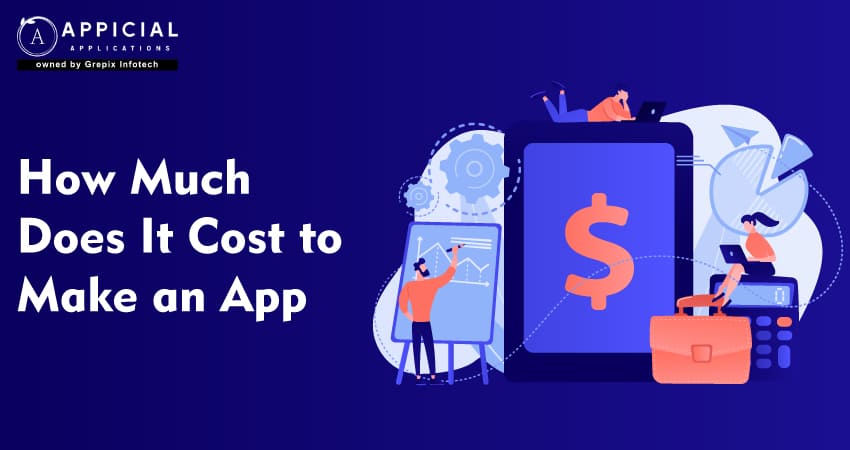
How Much Does It Cost to Make an App
Understanding the costs involved in app development is essential for any business owner venturing into the digital space. The price of creating an app hinges on numerous factors, making it challenging to pinpoint an exact figure without detailed planning and clarity on the project's scope. This article will delve into the myriad elements that influence app development costs, offering insights into the multifaceted nature of building a mobile application.
Mobile app development encompasses the creation of software applications tailored for mobile devices, aiming to address specific business needs or opportunities. This process spans market research, user interface design, coding, testing, and deployment, each requiring a unique set of skills and expertise. Prioritizing aspects such as cost, speed, and quality is crucial, as each choice involves trade-offs that directly impact the project's outcome.
This blog will explore various factors influencing app development costs and juxtapose the different components involved in the app creation journey. Continue reading to gain insights into the potential investment required to develop an app.
This comprehensive guide delves into the multifaceted world of app development costs, revealing that expenses extend beyond mere coding and design. It highlights how factors such as app complexity, platform choice (iOS, Android, or both), design intricacies, and the development team's location significantly influence the budget. Additionally, it discusses the importance of considering post-launch maintenance, marketing efforts, and the potential return on investment. Emphasizing strategic planning and quality focus, the blog underscores the potential for substantial returns in the dynamic app market, particularly for ride-hailing services, advocating for transparency and strategic partnership between developers and clients to transform visionary app ideas into reality.
What is Mobile App Development?
Mobile app development is the craft of creating software specifically designed for mobile devices, including smartphones and tablets, across various platforms like iOS, Android, and Windows. This intricate process starts with pinpointing a business need or opportunity that a mobile app could solve, followed by thorough market research to understand potential users' needs, preferences, and the competitive landscape. At the core of our services, the development of an app is more than coding—it's about bringing your vision to life on millions of devices worldwide.
The journey then progresses to the design phase, where a development team conceptualizes the app’s user interface and experience. This phase often involves drafting wireframes and prototypes to evaluate the app's usability and functionality. Following design, the development phase kicks in, requiring developers to code the app into existence, utilizing programming languages such as Java, Swift, or Kotlin, and leveraging mobile app development frameworks and tools.
Testing and debugging play essential roles in ensuring the app operates flawlessly and aligns with user expectations. This phase includes a series of tests to uncover and fix any issues within the app’s code. Upon completion, the app is ready for deployment, necessitating adherence to the specific guidelines of app stores like Apple’s App Store or Google Play for public access.
Overall, creating a mobile app is an intricate, skill-intensive process encompassing market research, design, development, testing, and deployment. It’s a journey of patience and dedication, demanding a commitment to quality at every step.
What Is Important To You When Developing An App?
When embarking on app development, identifying your key priorities is crucial for steering your project towards success. These priorities could range from focusing on cost efficiency, ensuring rapid development, or uncompromising on the quality of the final product. Each priority comes with its own set of trade-offs; for instance, prioritizing cost might mean scaling back on complex features to maintain a lean budget, whereas emphasizing speed could compromise the app’s thoroughness and quality. On the other hand, if quality is non-negotiable, be prepared to invest both time and resources to refine and perfect your app, possibly extending timelines and increasing costs. Ultimately, understanding and clearly defining what is most important to you and your target users will guide critical decision-making throughout the development process, ensuring that your app not only meets but exceeds expectations.
Factors That Will Influence App Development Cost
The cost of app development is influenced by a variety of factors, each contributing to the final investment required to bring an app from concept to launch. Understanding these factors can help you estimate the budget for your app project more accurately:
- Complexity and Features: The more complex the app, with features such as real-time synchronization, complex back-end integration, or advanced AI, the higher the development cost. Simple apps with basic functionalities like a calculator or a timer will cost significantly less than feature-rich applications such as social media platforms or online marketplaces.
- Platform Choice: Developing for iOS, Android, or both platforms can affect the cost. Native development for each platform involves different skill sets and development times, while cross-platform development can reduce costs but may impact performance and user experience.
- Design Requirements: Custom designs, animations, and user experience considerations increase development time and cost. A more sophisticated UI/UX design requires more detailed work, impacting the overall budget.
- Development Team: The cost of hiring a development team varies significantly based on their location, experience, and expertise. Agencies in North America and Western Europe tend to charge more than those in Eastern Europe or Asia due to differences in living costs and hourly rates.
- Maintenance and Updates: Post-launch maintenance, bug fixes, updates, and new features are often overlooked in initial cost estimates. Regular updates are crucial for keeping the app functional and competitive, contributing to ongoing costs.
- Integration with Third-party Services: Integrating third-party APIs for services like payment gateways, social media, or maps can add to the cost due to the additional development work required to ensure seamless integration.
- Backend Infrastructure and Administration: Complex apps requiring backend servers for data management, processing, and storage will see increased costs. Developing a custom backend and administration panel requires additional resources and time.
- Testing and Quality Assurance: Comprehensive testing across multiple devices and operating systems to ensure functionality, usability, and performance can significantly impact development costs. The more extensive the testing, the higher the assurance of app quality but at an increased cost.
- Security Measures: Implementing advanced security features to protect user data and comply with legal standards (like GDPR for European users) requires additional development efforts, thus increasing costs.
- Deployment and Market Release: Costs associated with launching an app, including app store fees, marketing, and promotional activities to gain initial traction, should also be considered in the overall budget.
Important Factors That Will Influence App Development Cost
In-house VS Agency App Development
1. In-house App Development
In-house app development involves utilizing your organization's internal resources and team members to create a mobile application from scratch. This approach allows for a high degree of control over every aspect of the development process, from initial concept to final deployment. By developing an app in-house, companies can ensure that the project aligns closely with their business goals, culture, and specific requirements. It fosters seamless communication and immediate feedback loops among team members, potentially leading to more efficient iterations and customization. However, this method may require significant upfront investment in talent acquisition, training, and technological infrastructure. Additionally, it places the responsibility for project management, technical challenges, and ongoing maintenance squarely on the company. Despite these challenges, in-house development can be highly rewarding for organizations with the necessary resources and a clear vision for their app, offering unparalleled alignment with strategic objectives and the flexibility to pivot as needed.
2. Agency App Development
Agency app development offers a comprehensive solution for businesses seeking to create mobile applications without the overhead of expanding in-house teams. By collaborating with a specialized agency, businesses gain access to a diverse pool of expertise across design, development, and testing phases, ensuring a high-quality product. Agencies expedite the development process, incorporating industry best practices and innovative approaches. Although the initial investment might be higher, the value delivered through expert execution, efficiency, and market insights often justifies the cost, leading to a successful app that aligns with business goals and user expectations, ultimately offering a competitive edge in the digital marketplace.
Native VS Hybrid App Development
1. Native app development
Native app development involves creating applications specifically designed to operate on a particular mobile operating system, using languages and development tools that are native to that platform. For iOS, this means using Swift or Objective-C and for Android, Kotlin or Java. The primary advantage of native development is the ability to fully utilize the capabilities of the underlying device, offering optimal performance, superior user experience, and seamless integration with the device's hardware features, such as cameras, microphones, and GPS. Native apps can more effectively leverage the device's processing speed and are generally more responsive and faster than their hybrid counterparts. Moreover, they adhere closely to the guidelines of the respective app stores, potentially resulting in a higher acceptance rate during the submission process. However, this approach requires developing and maintaining separate codebases for each platform, which can increase development time and costs. Despite these challenges, native app development is often preferred for projects where performance and user experience are critical priorities.
2. Hybrid app development
Hybrid app development merges web and native app features, allowing for the creation of apps that can operate across multiple platforms using a single codebase. This method utilizes web technologies like HTML, CSS, and JavaScript, which are then encapsulated within a native shell, enabling them to access the device's capabilities such as the camera and GPS, much like a native app. Hybrid development is favored for its cost-effectiveness and efficiency, as it significantly reduces development time and resources by eliminating the need to create separate versions for each platform. However, this approach might not always match the performance and smooth user experience of native apps, especially for highly interactive or resource-intensive applications. Despite this, for many businesses looking to establish a broad market presence quickly and economically, hybrid app development offers a compelling solution, balancing performance with cross-platform flexibility.
Android VS iOS App Development
1. Android app development
Android app development caters to the global market with its open-source platform, allowing for extensive customization and flexibility across a wide range of devices. Utilizing languages such as Kotlin and Java, developers create applications that vary from simple tools to complex systems, addressing a broad audience. The diversity of Android devices poses challenges in ensuring app consistency, but it also opens up unparalleled market opportunities. With Android's dominant market share and developer-friendly app store policies, launching an app on this platform offers a direct route to engaging with users worldwide, making it an attractive choice for developers aiming for maximum reach and impact.
2. iOS app development
iOS app development is tailored to create applications for Apple's iOS operating system, which runs on iPhone, iPad, and iPod Touch devices. Developers use Swift or Objective-C languages and work within Apple's integrated development environment, Xcode, to build, test, and deploy their apps. The iOS platform is known for its high-security standards, sleek user interface design, and a seamless user experience, attracting a demographic with high engagement levels and willingness to spend on apps. Despite the relatively smaller market share compared to Android, iOS offers access to a lucrative market, particularly in affluent regions. The App Store's rigorous review process ensures quality and security but requires developers to adhere closely to Apple's guidelines. iOS app development stands out for its potential for high revenue per user and a loyal customer base, making it a preferred choice for many businesses and developers looking to make a significant impact in the mobile app market.
The cost to build a ride-hailing app like Uber
Developing a ride-hailing app like Uber involves a substantial investment due to the complexity and range of functionalities required. The cost can vary widely, typically ranging from $0 to over $20,000, depending on factors such as app features, platform choice (iOS, Android, or both), design uniqueness, and backend infrastructure. Essential features like GPS navigation, payment integration, real-time tracking, user and driver interfaces, and ratings and reviews system are critical to the app's functionality and contribute to the development cost. Additionally, costs may increase with the inclusion of advanced features like ride scheduling, dynamic pricing, and driver and rider analytics. Maintaining high security and privacy standards further adds to the development expenses. While the initial investment is significant, the potential for high returns in the rapidly growing ride-hailing market makes it a worthy venture for businesses aiming to enter this domain.
Conclusion
In conclusion, as a leading taxi app development company, we understand that the journey to creating a successful app is paved with varied costs and considerations. The investment required to bring an app to life extends beyond the initial coding and design phase, encompassing a spectrum of factors from functionality and platform choice to post-launch maintenance and marketing efforts.
The cost of developing an app is significantly influenced by the geographical location of the development team, as rates can vary widely from one region to another. Additionally, the team's experience and skill level are crucial factors that affect the overall development expenses. It's vital for businesses to have a clear understanding of their budget and the specific needs of their project when assessing app development costs. Evaluating the app's potential to yield a return on investment is also key, as it can provide a rationale for the initial expenditure involved in bringing the app to market.
Our experience shows that while the costs to develop an app can start from a modest sum for basic functionalities, they can quickly escalate for more advanced and feature-rich applications. However, with strategic planning, clear prioritization, and a focus on quality, the investment in app development can drive substantial returns, especially in the dynamic and growing market of ride-hailing services. We're committed to navigating these complexities with our clients, ensuring transparency in costs and delivering exceptional value, thereby turning visionary app ideas into reality.





